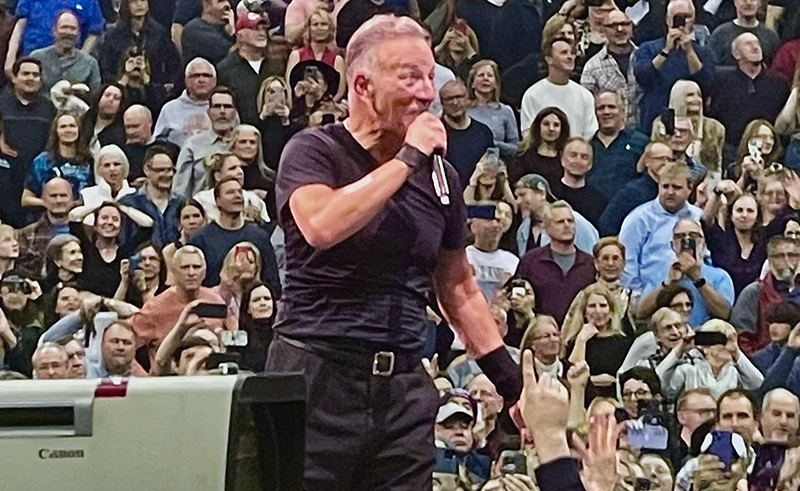
A reputation can be a tricky thing to live up to, especially one forged and perfected over a 50-year career. Few performers in the live-music world have a reputation as mythical and gilded as Bruce Springsteen’s. When he took the stage at the T-Mobile Center in downtown Kansas City on February 18, he faced a Titanic tide of sky-high expectations—no matter that he turned 73 in September.
Those hopes were especially lofty in the wake of his first real whiff of controversy. No point in going into the details here, but after tickets went on sale and fans were confronted with astronomic prices, the backlash reached the Boss, whose reaction was a bit too lukewarm for many. Lesson learned by all: Artists these days, even the mightiest such as Taylor Swift and Springsteen, have little control over what happens to ticket prices amid dynamic pricing and the greedy grasp of second-hand markets. In the end, fans suffer the most. End of story.
Any concerns that prices would suppress attendance were dispelled quickly. The arena was as full as I’ve ever seen it. Every seat was filled, end-to-end, side-to-side, floor to rafters. If there was even a smattering of empty seats, it was light and undiscernible.
Fifteen minutes past the prescribed starting time, members of the E Street Band took the stage—none looking more swashbuckling than guitarist Little Steven Van Zant. He had bestowed upon himself a lavish plume of haberdashery seemingly pulled from the mid-1800s: a garish, wide-brimmed hat, a luxurious overcoat that reached his shins, and black boots that nearly reached his knees. He looked regal and of significant power and import, like D’Artagnan’s consigliere.
His boss’s fashion, however, was austere as the working class he likes to write about: short-sleeved black T-shirt tucked into black pants with black work boots. Dressed for success, in other words.
Before the crowd was done venting its glee at the band’s arrival, they all clocked in and went to work, opening with one of a dozen or so roof-rattling anthems, No Surrender, a firestorm he usually saves for later in the show to sustain or raise momentum. Not tonight, though. This show was going to be different. The intent was to start fast and high and stay there—take the crowd on a panoramic journey.
After Ghosts, a jaunty anthem from Letter To You, his most recent studio album, Springsteen did some bookkeeping: Saxophonist Jake Clemons (nephew of the late Clarence Clemons), he told the crowd, was back at the hotel, eating barbecue, watching adult films, and dealing with COVID. He then orchestrated a full-house cheer that ended with him asking, “What’s that spell?” and the crowd returning “F*** COVID!” He introduced Clemons’ stand-in, long-time E Street road warrior Eddie Manion, who filled in dynamically.
Then it was back to business: pulling tracks from nine of his 20 studio albums, starting with Prove It All Night, which could be the everlasting motto of every Springsteen show and tour. It gave Manion his first chance to flash some keen chops, and he did.
After the title track to Letter To You, a low-tempo, palate-cleansing ballad, he swerved back to more classic songs from more beloved albums, such as The Promised Land, which featured the first appearance of his four backup singers, who added much soulful vocal heft and polish to everything they touched. Springsteen would add some blues harp to the mix and multi-instrumentalist Soozie Tyrell laid down some warm violin lines.
Then: Out on The Street, the only track from The River album. Like so many Springsteen songs, it’s baubled with primitive, non-lyric vocals—the oh-oh-ohs, la-la-las, lie-lie-lies–that stoke already inflamed crowd sing-alongs.
Candy’s Room, a song of his like none other, raised the mood even higher. As its crescendo exploded into the chorus, the arena erupted into a wave of pumped fists, waved arms, bodies bobbing and weaving. Then the instrumental interlude, Springsteen unleashed some high-end classic-rock licks, with Max Weinberg on drums doing all the heavy lifting—take a bow, sir.
The crowd enjoyed the cover of the Commodores’ Nightshift more than I did. The intent felt genuine, but the execution felt off. No worries. That was sandwiched between two songs from his second full-length, The Wild, the Innocent and the E Street Shuffle, released in 1973.
Springsteen was a different songwriter then, lyrically and musically, still in his Dylan-homage stage, and his band was more of a polyphonic orchestra that dabbled in rock, jazz, funk, soul, and R&B. Fifty years later, this iteration of the E Street Band revived those jammy, deep-grove sounds with ease and panache. They all took their moments to embellish the songs with brief but concise solos.
They would perform three tracks from that album–my favorite among his 20: Kitty’s Back, The E Street Shuffle, and Rosalita (Come Out Tonight)–one of the greatest party anthems ever. It was deeply gratifying to watch him embrace that fleeting period of his career, which had been mostly eclipsed by what ensued: career-defining blockbusters like Born to Run and Born in the USA. Kitty’s Back was particularly incendiary and my favorite moment of the night: a song I’d given up hope of hearing live. It was worth the wait.
Plenty of grand moments followed that chapter of the evening. It’s a cliché, but some cliches are apt and worthy: Nearly the entire show was a highlight, like one prolonged encore. Johnny 99 was a high-speed, horn-infested odyssey in Jersey rock-and-roll bar-band reverie. This version of Backstreets was modified a bit, vocally and instrumentally, but without significantly altering its original form, which wades deep into rock opera.
Nils Lofgren embroidered Because the Night with a brief guitar solo, spinning like a top through most of it. Something about Wrecking Ball felt almost Celtic-rockish as if the Pogues were covering it. Maybe it was Tyrell’s fiddle/violin riffs.
There would be no formal encore, no abandoning the stage and taking shelter backstage while the crowd begged for more. Instead, after a raging bonfire rendition of Badlands, Springsteen summoned everyone from their posts to join him up front, where they all locked arms and took a deep bow. Then it was back to your stations for more music, seven more songs to be precise.
Most performers would have stopped after the 1-2-3 punch of Thunder Road, Born to Run, and Rosalita, which seemingly ripped the mood into smithereens—a moment no band wants to follow.
But there were plenty more salvos in the chamber, starting with Glory Days, a paean of sorts to all the Uncle Ricos out there who can’t stop reliving their days as high school sports stars. Ironic, though, that five decades into his career, Springsteen is still living the glory, still pitching 90-mph fastballs and tossing footballs 75 yards.
The timeless and fail-proof Tenth Avenue Freeze-Out, the penultimate encore number, was also a tribute to the other missing Clemons, Clarence, the one-and-only Big Man name-checked in the song. It set up the closer perfectly, See You In My Dreams, a hymn, and eulogy to friends and loved ones in the after-life: “I’ll see you in my dreams / Around the river bend / For death is not the end / And I’ll see you in my dreams.”
No doubt, many went home that night reliving that show in their dreams, as affirming and uplifting as it was. This is a completely unscientific take, but according to what I heard, saw, and read in the aftermath, no one was talking about ticket costs or dynamic pricing. Rather, everyone looked and sounded like every minute of this show, which lasted 15 minutes shy of three hours, was worth more than every penny spent.
SETLIST
No Surrender, Ghosts, Prove It All Night, Letter to You, The Promised Land, Out in the Street, Candy’s Room, Kitty’s Back, Nightshift, The E Street Shuffle, Johnny 99, Last Man Standing, Backstreets, Because the Night, She’s the One, Wrecking Ball, The Rising, Badlands, Thunder Road, Born to Run, Rosalita (Come Out Tonight), Glory Days, Dancing in the Dark, Tenth Avenue Freeze-Out, I’ll See You In My Dreams.


